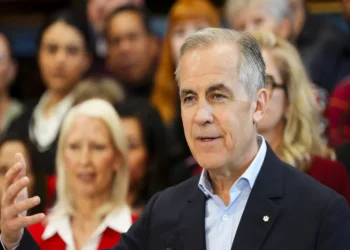The fight between the Trump administration and elite higher education institutions has hit a fever pitch, escalating once again after Harvard University filed a lawsuit in response to the federal government freezing over $2 billion in federal research funding. The freeze came after Harvard issued a blanket refusal to a list of conditions issued by the Trump administration on April 11 that set stipulations for the university to continue receiving federal research funds. The conditions sent to Harvard come amid a larger effort by the Trump administration to review federal grants and loans to ensure compliance with a slate of recent executive orders, including one issued on Jan. 21 regarding diversity, equity, and inclusion practices and programs.
The leading agent for the government in this effort — beyond President Donald Trump himself, of course — is the Joint Task Force to Combat Anti-Semitism, which was formed as a response to campuses’ utter failure to defend Jewish students and faculty in the wake of Hamas’s terrorist attacks on Israeli citizens in October 2023. And it is under this auspice, that of addressing Harvard and other institutions’ inability or unwillingness to uphold their commitments to civil rights in the face of antisemitism, that the Trump administration is targeting these schools’ finances. While there are other institutions in the administration’s crosshairs, notably Columbia, it is Harvard that has become the primary target. Indeed, it has been reported that the Trump administration even began reviewing Harvard’s tax-exempt status in mid-April.
As with so much involving Trump and, by extension, his administration, the whole saga is a colossal mixed bag. This is particularly true for constitutionally minded conservatives, among whom I count myself. But even for those whose entire aim is to tear a hole in the foundation of woke elite colleges (not the worst goal, admittedly), Trump’s unabashed broadside has plenty of downsides. Again, as is the wont of Trumpian politics, the idea has much to like, but the execution is left wanting.
The current status quo of higher education is, at best, untenable and, more frequently, malignantly detrimental. The idea of tying federal research funds to free speech and college and universities’ commitment to free inquiry and equal treatment under the law is a good one — something I, along with the American Enterprise Institute’s Frederick M. Hess, have advocated since 2019. The method in which the Trump administration has sought to use the latter to address the former is, unfortunately, quintessentially Obama-ian in its execution.

The Obama administration, in all its social justice zealotry and arrogant disregard for institutional restraint, used the blunt hammer of policy to threaten, coerce, and attack conservatives, religious institutions, and political rivals on everything from tax disclosure to healthcare to constitutionally permitted religious freedom. It did the same thing, and often worse, in the realm of education, both K-12 and higher ed, whether on free speech, gendered bathrooms, or sexual assault and harassment. In each of these instances, the hallmark of an Obama-era policy was the blatant contravening of congressionally mandated procedure, a hefty amount of constitutionally prohibited executive overreach, and an almost gleeful attitude of ideological warfare against private actors.
Take, for instance, the Obama-era “guidance” on sexual assault on campuses. In an infamous 2011 “Dear Colleague” letter issued by the Department of Education’s Office for Civil Rights, the Obama administration informed all schools receiving federal funds to use the “preponderance of evidence” standard, the lowest possible standard of proof in our judiciary system, in all investigations of sexual harassment, ranging from unwelcome sexually charged speech to sexual assault and rape. The letter also imposed a form of double jeopardy by requiring schools to allow accusers to appeal not-guilty rulings and “strongly discouraged” them from allowing cross-examination of accusers. In a self-proclaimed “blueprint” for Title IX compliance issued in 2013, the Education and Justice departments further instructed schools to adopt a shockingly expansive and unconstitutional definition of sexual harassment and made clear that conduct needn’t even be considered “objectively offensive” by a “reasonable person” to constitute harassment.
As I summarized in 2017, “Despite feigning to Congress that these documents only constituted ‘guidance,’ the Obama administration continued to promulgate these standards in their investigations into colleges and universities’ Title IX procedures. The destructive result was twofold: To avoid federal investigations, colleges and universities adopted overbroad speech codes and increasingly moved toward inquisitorial-style investigations of campus sexual harassment and assault — simultaneously violating constitutionally protected rights of free speech and due process.” These machinations were opposed across the spectrum, including not only by the Foundation for Individual Rights and Expression and various civil rights organizations but also the left-wing American Association of University Professors and, ironically, more than a score of Harvard Law School faculty members, among others.
It took nearly the entirety of Trump’s first term for Education Secretary Betsy DeVos and her team to unravel, repeal, and replace the unconstitutional morass the Obama team left in its wake. And, it should be reiterated, the careful, methodical, and procedurally supported guidance and policies established by the department are a crowning achievement of the first Trump administration and were deservedly praised by not just conservatives but legal experts and education stakeholders as well.
But methodological reform doesn’t give quite the rush that giving your enemies a taste of their own medicine does, unfortunately. Through a series of extralegal guidance documents, the Obama administration used the specter of federal punishment and funding reconsideration to coerce colleges into adopting kangaroo courts that trampled on the Constitution and students’ rights. While the Trump administration’s federal research demands do not go that far, they remain rife with similar overreach, occasionally lacking in clarity and even fundamental consistency, an end-around to necessary, legal executive procedure. Indeed, in many ways, it almost seems as if “do unto others as they have done unto you” retribution is the point. As David Kane at Minding the Campus muses, one can question whether the demands of the April 11 letter to Harvard were constructed to force the university to refuse.
That letter, which prompted the Harvard lawsuit, stipulated several conditions for unfreezing the $2.2 billion in federal research funds. Some of these are clearly oriented toward protecting students and combating antisemitism — such as demanding a universal mask ban, as masks are often used in protests and violent actions taken against students and university property — but are far afield of research projects and efforts the funding goes toward. Another stipulates that “Harvard must investigate and carry out meaningful discipline for all violations that occurred during the 2023-2024 and 2024-2025 academic years.” I have written in these pages that the so-called discipline handed out by Harvard, Columbia, New York University, and other schools in the wake of the October protests was lax to the point of negligence, but to require schools to retry investigations already carried out is tantamount to double jeopardy, itself an unconstitutional violation of students’ rights.
Several of these requirements are also facially inconsistent. For instance, the Trump administration letter demands that Harvard abolish ideological litmus tests for hiring and admissions. This is a good thing in theory. Litmus tests are anathema to free inquiry, enforce myopic orthodoxy, and are arguably unconstitutional at public universities, which, of course, Harvard is not. However, they also demand that “every department or field found to lack viewpoint diversity must be reformed by hiring a critical mass of new faculty within that department or field who will provide viewpoint diversity; every teaching unit found to lack viewpoint diversity must be reformed by admitting a critical mass of students who will provide viewpoint diversity.” While this is a much better form of a litmus test, directed to add viewpoint diversity rather than limit or remove it, it is still a litmus test! This is not only logically inconsistent with the first directive, but it also violates another directive in the letter: that of merit-based hiring for faculty and merit-based admissions. You can hire on merit, or you can hire on ideological viewpoint, but you cannot do both at once, especially when you also have a superseding demand to “make up the numbers” to reach ideological parity. The Trump administration would also require a third-party audit of faculty, staff, and students to achieve such viewpoint diversity, to be approved by the federal government, which is its own can of worms — so much for reducing the size of the federal bureaucracy.
Moreover, this all flies in the face of the institutional rights of private actors such as Harvard under the First Amendment. As does the requirement that Harvard reform its corporate governance structure. Other conditions in the letter also trample on First Amendment jurisprudence. In a 9-0 opinion just last year in Moody v. NetChoice, the Supreme Court reemphasized the limits the Constitution places on the government in its interactions with private actors: “On the spectrum of dangers to free expression,” the court wrote, “there are few greater than allowing the government to change the speech of private actors in order to achieve its own conception of speech nirvana.”
The Trump freeze also adopted the Obama administration’s favored maneuver for troublesome required procedure: just skip it. Unfortunately for them, the law doesn’t work that way. The relationship between the federal government and higher education institutions regarding public research dollars is set in statute, including those involving the Civil Rights Act, which governs discrimination such as antisemitism, and thus requires following procedure to make sure that exchange works for both parties. As the First Amendment experts at FIRE so helpfully summarize, this relationship “has rules to protect colleges, the government, and the taxpayers who foot the bill from being negatively affected by arbitrary decisions. Before the federal government can pull funds from an institution, it has to take a series of steps.
First, the Department of Education must investigate complaints about discrimination. If it finds problems, ED is required to work with an institution to address those problems ‘by informal means whenever possible.’ This is the most common process, where the department’s Office for Civil Rights enters into a ‘resolution agreement’ with an institution to ensure compliance with Title VI.
In order to strip federal funding, the department must give notice to the institution again and provide an opportunity for an administrative hearing where the institution can challenge the determination. If the determination stands, ED then has to report this to Congress and give 30 days’ notice before it actually terminates funding to the affected programs. ED may also refer the matter to the Department of Justice for litigation. In short, one way or another, the federal government is going to have to provide evidence and prove its case if it wants to pull out of the deal.”
Government by fiat was what the Obama administration attempted. It was a disaster. Worse, the Trump administration has set itself up for failure in its bungling of a good reform. I am no lawyer, but it seems unlikely the freeze on Harvard research funds will survive the lawsuit. A federal judge already blocked a funding freeze back in January. Perhaps whatever ruling comes down makes it more clear what the lines are regarding punishing bad actors while respecting institutions’ First Amendment rights, or perhaps it will make it more difficult for the federal government to rein in the worst excesses of leftist control of colleges.
While protecting students and faculty against discrimination is a primary goal for both schools and the government, the one-size-fits-all lever of the antisemitism task force, even beyond its executive overreach and lack of procedure, is not a good policy. It is too broad, too unclear, and too far removed from the purpose of federal research funding. By focusing so much on co-opting the Democrats’ playbook of using the government to bully those it disagrees with, the Trump administration seems to have lost sight of where it can use similar policy measures effectively and within limits.
The First Amendment definition of free speech and the long-standing understanding of academic freedom are preconditions for effective research environments. This is the primary reason that the federal government, since World War II, outsources research to universities and the like as subcontractors, disbursing billions annually for research in medicine, defense, energy, and more. The $2.2 billion to Harvard that was on the line is a portion of the $9 billion plus that goes to Harvard and its affiliate entities, most of which are hospitals, and that $9 billion is only a portion of the tens of billions the government disburses every year to higher education institutions for research alone.
As I wrote with Rick Hess in 2019, “In spending these tens of billions, Washington is not seeking to support higher education’s degree granting and teaching; rather, it’s engaging scholars at colleges and universities as subcontractors with the skills and capacity to conduct necessary research. From the beginning, research grants and contracts have been funded under the nominal expectation that institutions receiving taxpayer dollars adhere to the tenets of responsible science — including the assurance that research questions, methods and reporting will be guided by an inviolable commitment to free inquiry.”
Today, however, as others and I have pointed out, including the Trump administration, there are legitimate concerns about whether universities are upholding their end of this bargain: an ideological makeup so overwhelmingly one-sided, restrictive speech and behavioral codes, activist bureaucrats who hamper research questions that go against leftist identitarian shibboleths. Many of the things the Trump administration points to in its letter. These are all conditions for poor science, flawed research, and stunted inquiry. Researchers, as we saw so often in the pandemic, can fall prey to confirmation bias, and a vast amount of social science proves that the more ideologically uniform a research environment, the greater the risk of that bias going unnoticed, being reinforced, and tainting results.
“But,” as we argued, “while campuses catering to enclaves of the like-minded is undoubtedly a societal problem, it’s not clear that there’s a constructive role for the federal government in addressing them — at least not when the issues involve tasks like teaching and campus culture. The salient policy issue does arise, however, when ideological homogeneity starts to yield formal policies and practices that stifle free inquiry, speech and discourse. While individual institutions are and should be free to set their own ideological compasses, the size and nature of the federal investment gives taxpayers a clear stake in ensuring that colleges and universities that accept federal research funds take free inquiry seriously.”
A much more reasonable policy response is to insist that colleges and universities that wish to receive taxpayer-funded research dollars should be expected to stand fast by a mission of free speech and inquiry. While this does not allow the federal government to mandate who Harvard’s administrators are or what classes they teach, as apparently it now wishes to do, future research funds could require universities’ speech codes to be consistent with First Amendment principles in order to be considered for eligibility. While going through the proper procedures, naturally. The threat of a lack of funding, we have seen both this month and in the Obama years, is often enough of a motivator for colleges to change their ways. By doing it legally, the administration could see results that are more concrete and lasting, not simply thrown out in court.
This is also consistent with the founding statutes and principles of the National Science Foundation and the government’s original commitment to contracting research in the first place, as well as policy decisions made in other administrations. In a 2009 presidential memorandum, Barack Obama directed the Office of Science and Technology Policy to require federal department and agency heads to adopt procedures ensuring scientific integrity. To that end, OSTP Director John Holdren issued a 2010 memorandum on the “foundations of scientific integrity in government,” asserting that “scientific progress depends upon honest investigation, open discussion, refined understanding and a firm commitment to evidence.” This commitment is today affirmed in federal grant-making agencies’ standards, including those of the Department of Health and Human Services, the Department of Energy, the Department of the Interior, NASA, and many others.
HARVARD’S BILLIONS ARE A PRIVILEGE, NOT AN ENTITLEMENT
As Vannevar Bush, head of the Office of Scientific and Research Development following the war, wrote as founding principles for what would become the NSF, “Scientific progress on a broad front results from the free play of free intellects, working on subjects of their own choice, in the manner dictated by their curiosity for exploration of the unknown. Freedom of inquiry must be preserved under any plan for Government support of science.”
This means protected from both the government and bad actors on the side of colleges and universities. During the Obama administration, and again during the Biden years, conservatives knew that government overreach was malignant, clumsy, and unconstitutional. But in the New Right’s desire to have the government do more than just “be limited,” it has fallen into the same trap. There are ways to use the federal government to promote freedom. Indeed, the federal government has the constitutional obligation to ensure free speech at public universities, and it is within both the common defense and promotion of the general welfare, not to mention NSF statutes, that it ensures public largesse for research is directed to those research environments capable of quality, even if they are private universities. But there are ways to do that more effectively, and legally, than trying to make the other side have a taste of its own medicine.
J. Grant Addison is the deputy editor of the Washington Examiner magazine.















